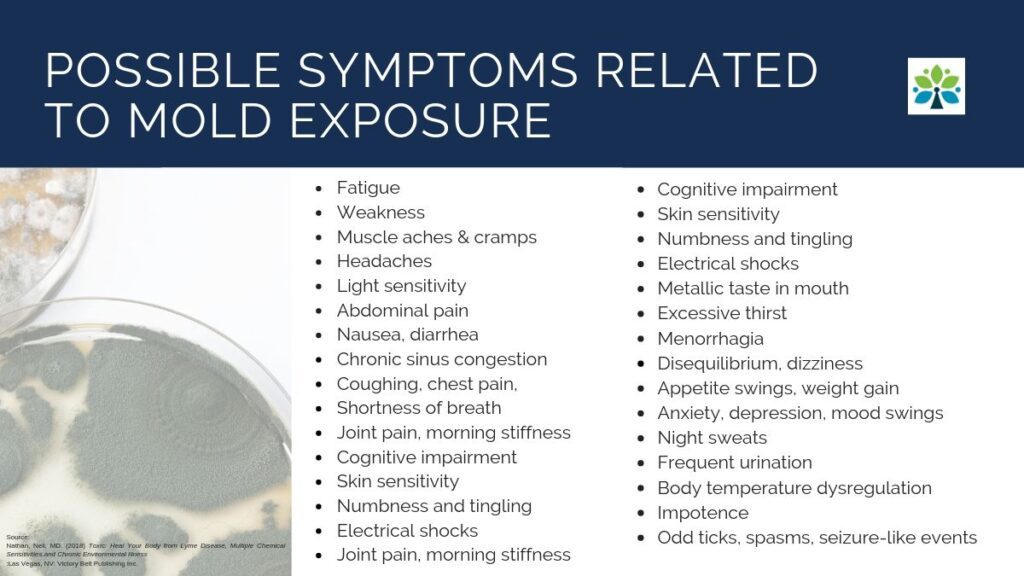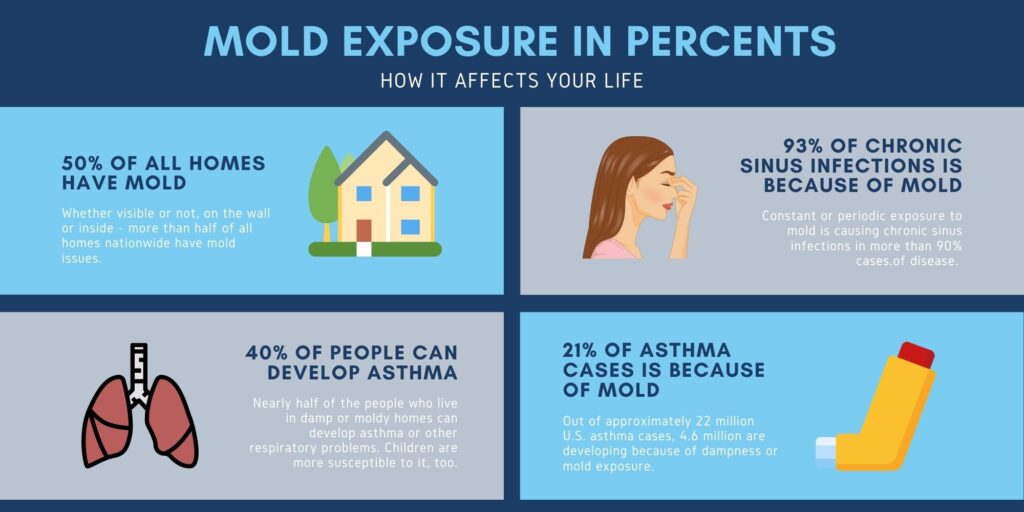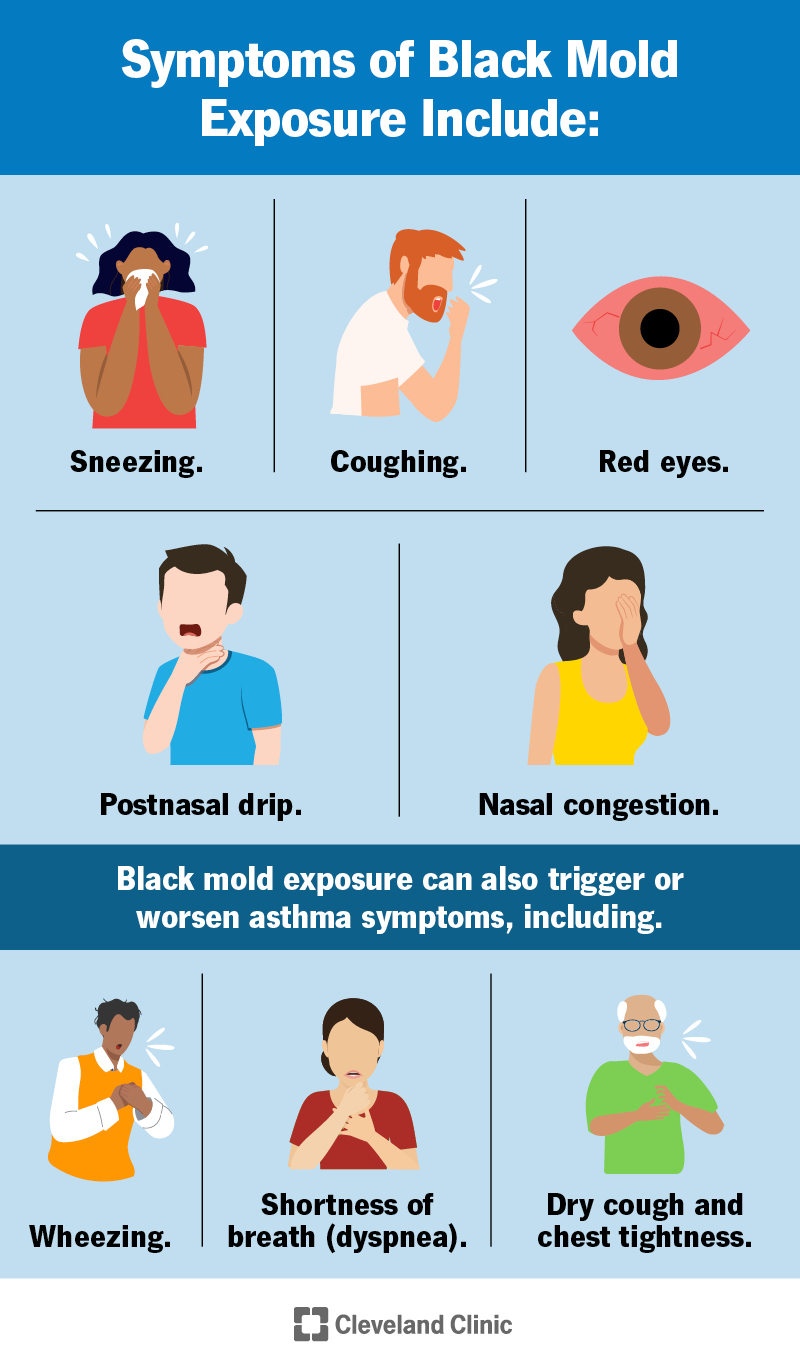Have you ever experienced unexplained health issues that seem to persist no matter what you do? From respiratory problems to allergies, these ailments can significantly impact your daily life. What if I told you that the culprit might be hiding in your own home? Yes, you heard it right! Mold, a silent intruder, can seep into the corners of your living space and wreak havoc on your health. In this article, we will explore the various symptoms of mold exposure, helping you become aware and take action to safeguard your well-being.
As you read through, you will discover how exposure to mold can lead to a range of health issues, from minor irritations to more severe complications. We will delve into identifying the signs that should raise a red flag, ensuring you can recognize potential health problems caused by mold in your home. So, get ready to arm yourself with knowledge and empower yourself to create a healthy living environment for you and your loved ones!

Causes of Mold in the Home
Moisture build-up
Moisture build-up is one of the main causes of mold growth in homes. When there is excessive moisture in the air or on surfaces, it creates the perfect environment for mold to thrive. Common sources of moisture build-up include water leaks, condensation, and high humidity levels. If you notice any signs of moisture in your home, such as damp walls, ceiling stains, or a musty odor, it is important to address the issue promptly to prevent mold growth.
Poor ventilation
Poor ventilation is another factor that can contribute to the growth of mold in your home. When there is insufficient airflow, moisture becomes trapped, allowing mold spores to settle and multiply. Areas with poor ventilation, such as bathrooms, basements, and attics, are particularly susceptible to mold growth. To improve ventilation, it is essential to open windows, use exhaust fans, and ensure proper air circulation throughout your home.
Leaky plumbing
Leaky plumbing can have a detrimental impact on your home’s indoor air quality and increase the risk of mold growth. Water leaks from pipes, faucets, or toilets can go unnoticed for extended periods, leading to hidden mold growth behind walls or under flooring. Regularly inspecting your plumbing system for leaks and promptly addressing any issues can help prevent mold growth and maintain a healthy living environment.
Common Mold Species in Homes
Aspergillus
Aspergillus is one of the most common types of mold found in homes. It can thrive in various damp environments and is often found in areas such as bathrooms and kitchens. While some species of Aspergillus are harmless, others can produce toxins that may cause respiratory problems and allergic reactions. Regular cleaning and maintenance can help control Aspergillus mold growth in your home.
Cladosporium
Cladosporium is another prevalent mold species found in homes. It can grow on both indoor and outdoor surfaces, such as carpets, wallpaper, and air conditioning systems. Cladosporium is known to trigger allergic reactions and respiratory issues in some individuals. Proper ventilation and keeping indoor humidity levels low can help prevent Cladosporium mold growth.
Penicillium
Penicillium is a type of mold commonly found in damp and water-damaged areas of the home, such as basements and bathrooms. While some species of Penicillium are used in the production of antibiotics, prolonged exposure to certain strains can cause allergic reactions and respiratory problems. Preventing moisture build-up and promptly addressing water leaks can help reduce the risk of Penicillium mold growth.
Symptoms of Mold Exposure
Allergic reactions
Exposure to mold can trigger allergic reactions in some individuals. Common symptoms include sneezing, itching, and a runny or stuffy nose. Allergic reactions to mold can vary in severity, with some people experiencing mild symptoms while others may have more severe reactions. If you notice symptoms of an allergic reaction when indoors, it may be a sign of mold in your home.
Respiratory issues
Mold exposure can also lead to respiratory problems, particularly in individuals with existing respiratory conditions such as asthma or chronic bronchitis. Breathing in mold spores can irritate the airways, leading to symptoms such as coughing, wheezing, and shortness of breath. If you experience respiratory issues that worsen when you are indoors, it is important to consider the possibility of mold in your home.
Skin irritation
In some cases, mold exposure can cause skin irritation. Direct contact with mold or inhaling mold spores can lead to itching, redness, and rashes on the skin. If you develop skin irritation that seems to be associated with certain areas of your home, it is essential to investigate and address any potential mold growth.
Allergic Reactions to Mold
Sneezing
One of the most common allergic reactions to mold is sneezing. If you find yourself sneezing more frequently when you are indoors, especially in specific areas of your home, it could be a sign of mold presence. Sneezing is the body’s way of trying to expel irritants from the nasal passages, and mold spores can act as triggers for this response.
Coughing
Mold exposure can also lead to coughing, which can be persistent or intermittent. Coughing is the body’s natural reflex to remove irritants from the airways. If you find yourself coughing more frequently or experiencing coughing fits when inside your home, mold could be an underlying cause.
Wheezing
Wheezing, a whistling or rattling sound produced when breathing, can occur as a result of mold exposure. Wheezing is often indicative of narrowing airways or inflammation in the lungs. If you notice wheezing or a persistent whistling sound when you breathe, it is important to consider mold as a potential cause and take the necessary steps to address the issue.
Respiratory Issues Caused by Mold
Shortness of breath
Shortness of breath is a common respiratory issue associated with mold exposure. When mold spores are inhaled, they can cause irritation and inflammation in the airways, leading to breathing difficulties. If you find yourself feeling breathless or struggling to catch your breath when you are indoors, it could be a sign of mold-related respiratory issues.
Chest tightness
Mold exposure can also cause chest tightness, which is often described as a feeling of pressure or constriction in the chest. This symptom can be alarming and may indicate that mold is affecting your respiratory system. If you experience recurrent or persistent chest tightness, it is important to investigate the presence of mold in your home.
Sinus congestion
Another respiratory issue commonly associated with mold exposure is sinus congestion. Mold spores can irritate the nasal passages and sinuses, leading to a stuffy or blocked nose. If you notice that your nasal congestion worsens when you are indoors or in certain areas of your home, mold may be a contributing factor.
Skin Irritation Caused by Mold
Itching
Direct contact with mold or inhalation of mold spores can cause itching on the skin. This itching sensation can be localized to a specific area or spread across larger areas of the body. If you experience persistent itching that seems to be related to certain rooms or areas of your home, it is important to consider the possibility of mold exposure.
Redness
Redness of the skin can also occur as a result of mold exposure. When the skin comes into contact with mold or mold spores, it can become inflamed, leading to redness and irritation. If you notice unexplained redness on your skin, particularly after spending time in certain areas of your home, mold may be a contributing factor.
Rashes
In some cases, mold exposure can cause rashes on the skin. These rashes can vary in appearance and severity, ranging from mild redness and small bumps to more extensive skin eruptions. If you develop a rash that seems to be associated with certain areas of your home, it is important to consider the presence of mold and take appropriate measures to address it.

Mold-Related Infections
Pneumonia
Exposure to certain types of mold can increase the risk of developing respiratory infections such as pneumonia. Mold spores can be inhaled deep into the lungs, leading to inflammation and infection. Pneumonia caused by mold is often more common in individuals with weakened immune systems or pre-existing respiratory conditions.
Bronchitis
Mold exposure can also contribute to the development of bronchitis, which is characterized by inflammation of the bronchial tubes. Inhaling mold spores can irritate the airways and trigger bronchial inflammation, leading to a persistent cough and difficulty breathing. Individuals with underlying respiratory conditions may be more susceptible to mold-related bronchitis.
Sinusitis
Sinusitis, or inflammation of the sinuses, can also be caused by mold exposure. Mold spores can irritate the nasal passages and sinuses, leading to congestion, facial pain, and pressure. Individuals with a history of chronic sinusitis may experience exacerbated symptoms when exposed to mold.
Children and Mold Exposure
Increased risk
Children are more vulnerable to the health effects of mold exposure due to their developing immune systems and smaller lung capacity. They may be more prone to respiratory issues, allergies, and skin irritation when exposed to mold. It is crucial to ensure a mold-free environment for children and promptly address any signs of mold growth in the home.
Asthma development
Exposure to mold during infancy or early childhood has been associated with an increased risk of developing asthma. Children with a family history of allergies or asthma are particularly susceptible. It is important to create a mold-free environment and take measures to prevent mold growth to reduce the risk of asthma development in children.
Developmental issues
Mold exposure may also have an impact on the cognitive and developmental aspects of children. Some studies have suggested a link between mold exposure and neurodevelopmental issues, although more research is needed to establish a definitive connection. Nonetheless, providing a mold-free environment is essential for promoting the overall health and well-being of children.

Pregnant Women and Mold Exposure
Complications
Pregnant women should be cautious about mold exposure, as it may lead to potential complications. Inhaling mold spores can irritate the airways and increase the risk of respiratory issues. Additionally, certain types of mold are known to produce toxins that can pose a risk to both the mother and the developing fetus. It is important for pregnant women to address any mold issues in their home to safeguard their health and that of their unborn child.
Respiratory health of fetus
Mold exposure during pregnancy can potentially affect the respiratory health of the fetus. Inhaling mold spores can lead to inflammation and respiratory issues in the developing lungs of the baby. Maintaining a mold-free environment and taking precautions to prevent mold growth is crucial for ensuring the optimal health of both the mother and the fetus.
Preterm birth risk
Some studies have suggested a possible link between mold exposure during pregnancy and an increased risk of preterm birth. While the exact mechanisms are not fully understood, it is believed that the inflammatory response to mold exposure could trigger early contractions. Pregnant women should be vigilant about mold prevention and promptly address any signs of mold growth in their living environment.
Prevention and Remediation Measures
Fixing leaks and moisture issues
To prevent mold growth in your home, it is crucial to address any leaks or moisture issues promptly. Regularly inspect your plumbing system for leaks and repair them immediately. Ensure proper drainage systems are in place to prevent water accumulation around your home’s foundation. Additionally, fix any roof leaks and maintain proper ventilation in areas prone to moisture build-up, such as bathrooms and kitchens.
Improving ventilation
Proper ventilation is essential for reducing moisture levels and preventing mold growth. Ensure your home is adequately ventilated by opening windows, using exhaust fans, and allowing air to circulate freely. In areas with high humidity, such as the bathroom, consider using a dehumidifier to control moisture levels and promote airflow.
Regular mold inspections
Regular mold inspections can help identify and address mold issues before they become extensive. Consider hiring a professional mold inspector to assess your home for any signs of mold growth. They can identify areas of concern, test for the presence of mold spores, and provide recommendations for remediation if necessary. Early detection and prompt action can help ensure a mold-free and healthy living environment.
In conclusion, mold growth in the home can have adverse effects on your health and well-being, particularly if left unaddressed. Understanding the causes, symptoms, and potential risks associated with mold exposure is crucial for taking the necessary preventive measures. By addressing moisture build-up, improving ventilation, and promptly addressing any signs of mold growth, you can create a mold-free environment and maintain a healthy living space for yourself and your loved ones.

